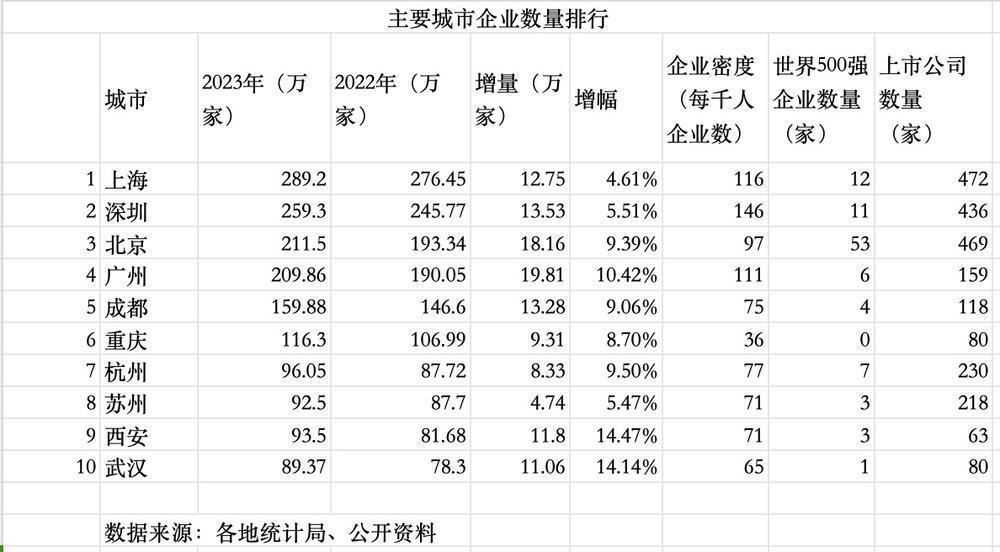
The competition among China's megacities has shifted from a "battle for talents" to a "battle for enterprises", signaling a new phase.
After research and analysis, it is found that Guangzhou, Beijing, and Shenzhen had the greatest increase in the number of new enterprises in 2023, growing by 198,100, 181,600, and 135,300 respectively. Each of these cities now boasts over 2 million enterprises. Shanghai, with a total of 2.892 million enterprises, remains the leader in overall numbers.
Guangzhou takes the lead in total and incremental enterprises
In terms of the total number of enterprises, Beijing, Shanghai, Guangzhou, and Shenzhen each surpassed the 2 million enterprise milestone in 2023. Meanwhile, Chengdu and Chongqing entered the "million club" with 1.5988 million and 1.163 million enterprises, respectively.
In terms of the incremental increase, Guangzhou led in both new registrations and net increase of enterprises in 2023, with 369,700 newly registered enterprises and a net increase of 198,100 compared with 2022, earning it the "double crown".
Compared to 2022, Guangzhou, Xi'an, and Wuhan saw double-digit growth in new registrations, at 10.43%, 14.47%, and 14.10% respectively. In terms of net increase, Xi'an, Wuhan, Foshan, and Guangzhou all experienced growth rates exceeding 10%, making them the top four winners in this "battle for enterprises."
Economic vitality is measured not just by the number of enterprises, but also by their quality.
For instance, the presence of a Fortune Global 500 company in a city can significantly boost the local economy through tax revenues and, by attracting upstream and downstream industries, resulting in industrial clusters worth hundred billion or even trillion yuan.
Beijing, Shanghai, and Shenzhen not only lead in the number of enterprises in total but also in the number of Fortune Global 500 companies, with 53, 12, and 11 respectively.
Among the new first-tier cities, Hangzhou stands out with 960,500 enterprises in 2023, a net increase of 47,400 from 2022, and seven Fortune Global 500 companies, ranking fourth nationwide.
The "battle for enterprises" enters the second half
There is not only competition among cities but also industrial collaboration. Through investment promotion, the movement of enterprises among cities allows for more efficient resource allocation and greater innovation.
Taking the interaction between city clusters in the Yangtze River Delta and the Guangdong-Hong Kong-Macao Greater Bay Area as an example,on March 7th, 2023, the Department of Commerce of Guangdong Province held a series of promotional events in Shanghai, including the "Guangdong Investment Promotion and Cooperation Conference (Shanghai)," a symposium with representatives from multinational companies, and a luncheon with representatives from the robotics industry. These events targeted headquarters enterprises and R&D centers to attract investments for manufacturing and headquarters. Over 200 companies participated in the events.
Five months later, on August 30th, a return visit was paid to Guangdong with the "Shanghai-Guangdong-Hong Kong-Macao Greater Bay Area Investment Promotion Conference" held in Guangzhou. During this event, service points for Changning, Jiading, and Qingpu districts were established in the Guangdong-Hong Kong-Macao Greater Bay Area, and strategic cooperation agreements were signed, involving 18 enterprises with a total investment of 17 billion yuan.
Source: Yangcheng Evening News
“抢企大战”来啦!超大特大城市竞争进入下半场
从“抢人大战”到“抢企大战”,中国超大特大城市竞争进入了下半场。
记者梳理发现,广州、北京、深圳是2023企业增量最多的三大城市,分别净增长了19.81万家、18.16万家和13.53万家,上述城市去年的企业数量均突破了200万家大关。而从企业总量来看,上海依然稳居全国第一,达到了289.2万家。

广州拿下“双料冠军”
2023年,从企业总量来看,北上广深四个城市齐齐站稳了200万家大关。成渝双城则双双跻身百万圈,企业数量分别达到了159.88万家和116.3万家。
从增量来看,2023年,广州新登记企业36.97万家,净增企业(2023年企业数减去2022年企业数)数量19.81万户,均排名全国第一,拿下了“双料冠军”。
与2022年相比,广州、西安和武汉的新登记企业数量同比均实现了两位数增长,分别为10.43%、14.47%和14.10%。从净增量来看,西安、武汉、佛山和广州的增速都超过了10%,成为“抢企大战”的四大赢家。
衡量一个地区的经济活力,既看企业数量,也看企业质量。
以世界500强榜单为例,对于所在城市来说,一家世界500强企业的诞生,不仅能产生总部经济的财税效应,还能带动上中下游产业链的聚集,从而形成百亿级乃至千亿级的产业集群。
北京、上海、深圳不仅企业数量遥遥领先,世界500强企业的数量也位居全国前列,分别为53家、12家和11家。
在新一线城市中,杭州表现出色,2023年,拥有96.05万家企业,对比2022年净增4.74万家,并孵化出了7家500强企业,在全国城市中排名第四。
“抢企大战”进入下半场
实际上,城市之间的“抢企大战”不只是单纯的竞争,也是一种相互之间的产业协作,在城市之间的互相招商中,企业的流动让资源配置更加有效,也能最大限度激发创新活力。
譬如,长三角城市和粤港澳大湾区城市群之间的互动。去年3月7日,广东省商务厅在上海举办“广东省招商合作推介会(上海)”“广东省与跨国公司代表座谈会”“广东省与机器人行业代表午餐会”。该系列活动重点面向总部企业和研发中心,围绕两个招商重点(制造业招商和总部招商),吸引超过200家企业参与。
5个月后的8月30日,上海“回访”广东。“相粤湾区,沪你同行”2023上海·粤港澳大湾区投资合作推介会在广州举行。活动中,长宁区、嘉定区、青浦区驻粤港澳大湾区服务点揭牌,投资上海·沪穗商协会战略合作启动。会上还举行了重点项目签约仪式,三区共与18家大湾区相关企业签约,总投资170亿元。
文、图|记者 陈泽云
翻译丨赵凡
-
ThePoint | Self-imposed obstacles 作茧自缚
2024-07-02 22:18:10 -
Poster | A 360° View of the Shenzhen-Zhongshan Link
2024-07-02 21:02:38 -
The fishing ban in the Xijiang River ends!
2024-07-02 21:52:52 -
The number of foreign nationals entering and exiting through Guangzhou Baiyun International Airport hits a record high
2024-07-02 21:53:20






